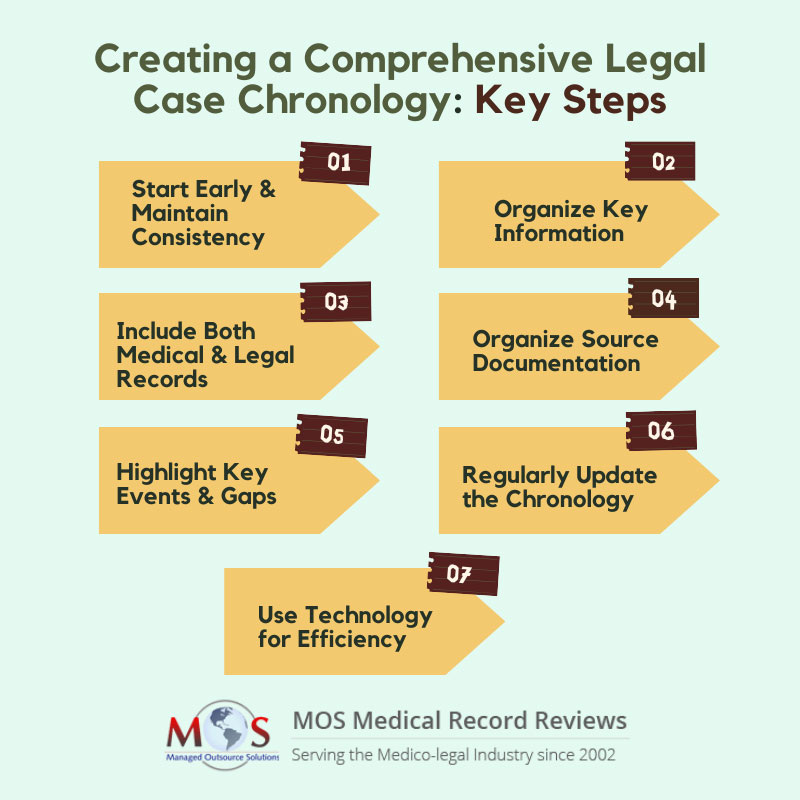In both legal and medical professions, well-organized and precise medical case chronologies play a vital role in building a comprehensive understanding of your case. For doctors and attorneys involved in litigation—especially in cases like medical malpractice, personal injury or workers’ compensation, having an organized timeline of events is crucial. A comprehensive chronology not only helps gain an understanding of the case but also aids in building a strong argument, identifying key information and simplifying medical data for the jury. However, crafting it is not only labor-intensive and time consuming, it also demands a strategic approach.
Here’s a step-to-step guide for creating a comprehensive legal case chronology:
- Starting Early and Consistency: The first and foremost step is to start early. Begin the process of creating a timeline, as soon as the case is accepted. Waiting until the last minute will result in unwanted errors, missing details and additional stress. Consistency also holds the key to maintaining a constant approach, ensuring that the chronology is uniform and hence, easy to follow.
- Organize All Key Information: These can include the following:
- Initial injury or incident
- Medical treatment dates (practice visits, surgeries, rehabilitation sessions)
- Communication logs (between patient, doctors, insurers, etc.)
- Legal actions (dates of filings, depositions, hearings)
- Make sure that all events are in chronological order and do not skip any minor details even though it may seem irrelevant as it might prove to be crucial as the case develops.
- Include Both Medical and Legal Records: In cases involving personal injury/incident, both medical and legal records will have a vital role and therefore, it is crucial to incorporate both records. For instance, medical reports may be cross-referenced with legal filings, in scenarios where deposition or mediation sessions are viewed in the context of the patient’s medical condition.
- Organize Source Documentation: Every activity in the chronology should have backing up evidence to support the findings. For example:
- Medical records provided should stand-in for the treatment dates, procedures and diagnoses.
- Legal records (motions, filings, orders etc.) should be tagged with the corresponding event.
- Correspondence (phone calls, emails etc.) should support communications logs included in the timeline.
- For each event, you should make a record of the document type, date and source (for example: “CT scan report from ABC Medical Center, dated 10/05/2024”). Proper arrangement of your sources will make it easier to retrieve and validate the records as the trial progresses.
- Emphasize Key Events and Gaps: Even though it is necessary to include all events, understand that not all events are important. Make sure to highlight the key aspects of the case, such as:
- Significant legal actions (certain court appearances or case filings)
- Critical medical interventions (major surgeries or critical treatment procedures)
- Important communications (mails from insurers or opposing counsel)
- Highlight these key events/gaps and address it in a timely manner with your client, health practitioner and other parties to ensure that no critical information is missed out.
- Regular Updating: Medical case chronologies evolve with the case and therefore, regular updating is required to keep up with the developments as the case progresses. Whether it is a new medical report or a legal point, make sure it is added as it helps prevent last-minute scrambling and keeps the legal and medical team aligned and updated.
- Technology for Efficiency and Accuracy: Drafting chronology manually is not only cumbersome, but susceptible to errors and inefficiencies. Handling tremendous volumes of medical and legal data in complex cases can be a daunting task. Making use of medico-legal practice management software can significantly reduce these risks. The software can automate the tasks — organizing, tracking and retrieving any information, at any time.
Accuracy is the cornerstone of a comprehensive chronology. Therefore, both manual and automatic validation can help review and validate the credibility of the chronology. Make sure to verify the dates, documents and ensure the events are in the proper order as even the smallest of errors can prove costly in court. For an even further enhanced level of accuracy, you may consider having an expert—healthcare practitioner or an attorney—to verify the timeline and subsequent events, for one last time.
The Significance of a Comprehensive Legal Case Chronology
A comprehensive chronology is not just a history of events presented in a sequential order but an inevitable, strategic tool for both attorneys and healthcare practitioners, in working towards producing a better outcome for their case. For attorneys, it is a map to connect the dots between legal actions and medical facts while for doctors, it provides valuable details in a properly organized form, and is also a helpful tool for juries and judges. It is helpful not only in marshaling a clear and coherent narrative but also preparing both parties for any challenge.
By laying out the timeline in clear, factual terms, you minimize your chances of getting blindsided by some new information or discrepancy at the trial. It also identifies crucial points involved in a case, such as medical interventions, major legal actions that took place in the courtroom, or communications breakdowns which are extremely crucial in arguments presented in the courtroom or during negotiations for settlement.
Medical case chronologies are essentially the backbone of any complex legal or medical case. By following the steps mentioned above—starting early, organizing carefully, integrating medical and legal data, highlighting key events, regular updating and incorporation of automation—you will be able to create very effective legal case chronologies that will give you that added advantage while preparing for that important case.
Choosing the Right Medical Record Review Company
Choosing the right medical record review company for drafting effective legal and medical case chronologies will ensure accuracy, reliability, and efficiency in building a strong narrative. It is important to make sure that the company you are partnering with has expertise in reviewing medical records. The company should have the capability in providing experienced medical reviewers who understand the complexities of medical terminologies, and documentation standards. Consider their reputation for attention to detail, adherence to deadlines, and ability to provide comprehensive case summaries.
Streamline Your Case Management with Us!





